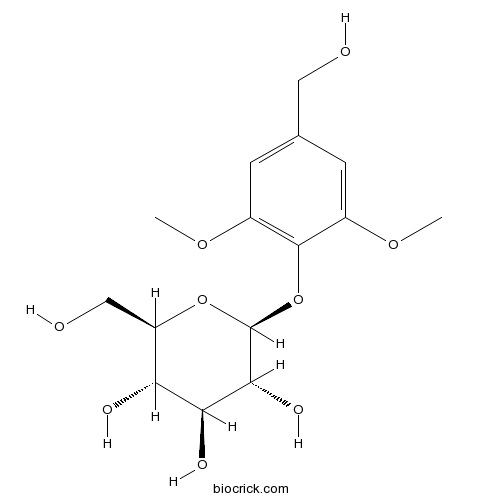Di-O-methylcrenatinCAS# 64121-98-8 |

Quality Control & MSDS
Number of papers citing our products

Chemical structure

3D structure
| Cas No. | 64121-98-8 | SDF | Download SDF |
| PubChem ID | 10736338 | Appearance | Powder |
| Formula | C15H22O9 | M.Wt | 346.33 |
| Type of Compound | Phenols | Storage | Desiccate at -20°C |
| Solubility | Soluble in Chloroform,Dichloromethane,Ethyl Acetate,DMSO,Acetone,etc. | ||
| Chemical Name | (2R,3S,4S,5R,6S)-2-(hydroxymethyl)-6-[4-(hydroxymethyl)-2,6-dimethoxyphenoxy]oxane-3,4,5-triol | ||
| SMILES | COC1=CC(=CC(=C1OC2C(C(C(C(O2)CO)O)O)O)OC)CO | ||
| Standard InChIKey | RWIINOLFQCPJMH-VVSAWPALSA-N | ||
| Standard InChI | InChI=1S/C15H22O9/c1-21-8-3-7(5-16)4-9(22-2)14(8)24-15-13(20)12(19)11(18)10(6-17)23-15/h3-4,10-13,15-20H,5-6H2,1-2H3/t10-,11-,12+,13-,15+/m1/s1 | ||
| General tips | For obtaining a higher solubility , please warm the tube at 37 ℃ and shake it in the ultrasonic bath for a while.Stock solution can be stored below -20℃ for several months. We recommend that you prepare and use the solution on the same day. However, if the test schedule requires, the stock solutions can be prepared in advance, and the stock solution must be sealed and stored below -20℃. In general, the stock solution can be kept for several months. Before use, we recommend that you leave the vial at room temperature for at least an hour before opening it. |
||
| About Packaging | 1. The packaging of the product may be reversed during transportation, cause the high purity compounds to adhere to the neck or cap of the vial.Take the vail out of its packaging and shake gently until the compounds fall to the bottom of the vial. 2. For liquid products, please centrifuge at 500xg to gather the liquid to the bottom of the vial. 3. Try to avoid loss or contamination during the experiment. |
||
| Shipping Condition | Packaging according to customer requirements(5mg, 10mg, 20mg and more). Ship via FedEx, DHL, UPS, EMS or other couriers with RT, or blue ice upon request. | ||
| Description | Standard reference |
| In vitro | Iridoid, phenylethanoid and flavonoid glycosides from Sideritis trojana.[Pubmed: 22024633 ]Fitoterapia. 2012 Jan;83(1):130-6.
|
| Structure Identification | Fitoterapia. 2013 Jul;88:38-43.Alkyl and phenolic glycosides from Saussurea stella.[Pubmed: 23567860]
|

Di-O-methylcrenatin Dilution Calculator

Di-O-methylcrenatin Molarity Calculator
| 1 mg | 5 mg | 10 mg | 20 mg | 25 mg | |
| 1 mM | 2.8874 mL | 14.4371 mL | 28.8742 mL | 57.7484 mL | 72.1855 mL |
| 5 mM | 0.5775 mL | 2.8874 mL | 5.7748 mL | 11.5497 mL | 14.4371 mL |
| 10 mM | 0.2887 mL | 1.4437 mL | 2.8874 mL | 5.7748 mL | 7.2185 mL |
| 50 mM | 0.0577 mL | 0.2887 mL | 0.5775 mL | 1.155 mL | 1.4437 mL |
| 100 mM | 0.0289 mL | 0.1444 mL | 0.2887 mL | 0.5775 mL | 0.7219 mL |
| * Note: If you are in the process of experiment, it's necessary to make the dilution ratios of the samples. The dilution data above is only for reference. Normally, it's can get a better solubility within lower of Concentrations. | |||||

Calcutta University

University of Minnesota

University of Maryland School of Medicine

University of Illinois at Chicago

The Ohio State University

University of Zurich

Harvard University

Colorado State University

Auburn University

Yale University

Worcester Polytechnic Institute

Washington State University

Stanford University

University of Leipzig

Universidade da Beira Interior

The Institute of Cancer Research

Heidelberg University

University of Amsterdam

University of Auckland

TsingHua University

The University of Michigan

Miami University

DRURY University

Jilin University

Fudan University

Wuhan University

Sun Yat-sen University

Universite de Paris

Deemed University

Auckland University

The University of Tokyo

Korea University
- 5-hydroxy-canthin-6-one
Catalog No.:BCN7910
CAS No.:64118-73-6
- Allomatrine
Catalog No.:BCN2368
CAS No.:641-39-4
- Alternariol
Catalog No.:BCN7147
CAS No.:641-38-3
- Sennidin A
Catalog No.:BCN6354
CAS No.:641-12-3
- H-Ala(3-pyridyl)-OH.HCl
Catalog No.:BCC3321
CAS No.:64090-98-8
- Cannabispirol
Catalog No.:BCN4609
CAS No.:64052-90-0
- GANT 58
Catalog No.:BCC1587
CAS No.:64048-12-0
- Ro 04-5595 hydrochloride
Catalog No.:BCC7234
CAS No.:64047-73-0
- Z-D-Pro-OH
Catalog No.:BCC2752
CAS No.:6404-31-5
- Boc-ε-Acp-OH
Catalog No.:BCC3205
CAS No.:6404-29-1
- Boc-Nle-OH
Catalog No.:BCC3296
CAS No.:6404-28-0
- Boc-Lys(Ac)-OH
Catalog No.:BCC3411
CAS No.:6404-26-8
- Longistylin C
Catalog No.:BCN4182
CAS No.:64125-60-6
- Sedanolide
Catalog No.:BCN8338
CAS No.:6415-59-4
- Nilotinib(AMN-107)
Catalog No.:BCC3643
CAS No.:641571-10-0
- Echinoynethiophene A
Catalog No.:BCN4183
CAS No.:64165-98-6
- 5-Acetyl-2-(1-hydroxy-1-methylethyl)benzofuran
Catalog No.:BCN7488
CAS No.:64165-99-7
- 30-Oxolupeol
Catalog No.:BCN6673
CAS No.:64181-07-3
- trans-2,3-Dihydro-3-hydroxyeuparin
Catalog No.:BCN6922
CAS No.:64185-57-5
- Z-Hyp-Ome
Catalog No.:BCC3258
CAS No.:64187-48-0
- Zanthobungeanine
Catalog No.:BCN6685
CAS No.:64190-94-9
- Senaetnine
Catalog No.:BCN2127
CAS No.:64191-69-1
- Barbinervic acid
Catalog No.:BCN4061
CAS No.:64199-78-6
- Alloimperatorin
Catalog No.:BCC8116
CAS No.:642-05-7
Alkyl and phenolic glycosides from Saussurea stella.[Pubmed:23567860]
Fitoterapia. 2013 Jul;88:38-43.
One alkyl glycoside, saussurostelloside A (1), two phenolic glycosides, saussurostellosides B1 (2) and B2 (3), and 27 known compounds, including eleven flavonoids, seven phenolics, six lignans, one neolignan, one phenethyl glucoside and one fatty acid, were isolated from an ethanol extract of Saussurea stella (Asteraceae). Their structures were elucidated by NMR, MS, UV, and IR spectroscopic analysis. Of the known compounds, (+)-medioresinol-di-O-beta-D-glucoside (7), picraquassioside C (10), and diosmetin-3'-O-beta-D-glucoside (27) were isolated from the Asteraceae family for the first time, while (+)-pinoresinol-di-O-beta-D-glucoside (6), Di-O-methylcrenatin (11), protocatechuic acid (14), 1,5-di-O-caffeoylquinic acid (17), formononetin (28), and phenethyl glucoside (29) were isolated from the Saussurea genus for the first time. The anti-inflammatory activities of three new compounds (1-3), five lignans ((-)-arctiin (4), (+)-pinoresinol-4-O-beta-D-glucoside (5), (+)-pinoresinol-di-O-beta-D-glucoside (6), (+)-medioresinol-di-O-beta-D-glucoside (7) and (+)-syringaresinol-4-O-beta-D-glucoside (8)), one neolignan (picraquassioside C (10)), and one phenolic glycoside (Di-O-methylcrenatin (11)) were evaluated by testing their inhibition of the release of beta-glucuronidase from PAF-stimulated neutrophils. Only compound 5 showed moderate inhibition of the release of beta-glucuronidase, with an inhibition ratio of 39.1%.


